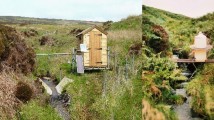Abstract
The microbial loop in flowing waters is dependent on allochthonous sources of carbon, which vary in quality. The proportion of dissolved organic carbon (DOC) that can be degraded ranges from <1 to over 50%, and the bioavailability of DOC (micrograms bacterial biomass produced per milligram DOC present) ranges over two orders of magnitude. Bioavailability of DOC is predictable from the ratio of H/C and O/C of the DOC, but further work is needed to develop simple predictors of bioavailability of DOC in a range of environments. Consumers of bacteria in streams range in size from protists to insect larvae, with highest rates of bacterial consumption found among the meiofauna and certain filter feeders and grazers. Because there appear to be fewer trophic transfers in the lotic microbial loop, it functions more as a link in flowing waters than it appears to do in the marine plankton.
Similar content being viewed by others
References
Bott TL, Kaplan LA (1990) Potential for protozoan grazing of bacteria in streambed sediments. J N Am Benthol Soc 9:336–345
Carlough LA, Meyer JL (1991) Bacterivory by sestonic protists in a southeastern blackwater river. Limnol Oceanogr 36:873–883
Couch CA, Meyer JL (1992) Development and composition of the epixylic biofilm in a blackwater river. Freshwater Biol 27:43–51
Cummins KW (1974) Structure and function of stream ecosystems. BioSci 24:631–641
DeHaan H (1993) Solar UV-light penetration and photodegradation of humic substances in peaty lake water. Limnol Oceanogr 38:1072–1076
Edwards RT, Meyer JL (1987) Bacteria as a food source for black fly larvae in a blackwater river. J N Am Benthol Soc 6:241–250
Edwards RT, Meyer JL (1990) Bacterivory by deposit-feeding mayfly larvae (Stenonema spp.). Freshwater Biol 24:453–462
Findlay S, Meyer JL, Smith PJ (1984) Significance of bacterial biomass in the nutrition of a freshwater isopod (Lirceus sp.). Oecologia 63:38–42
Findlay S, Meyer JL, Smith PJ (1986) Incorporation of microbial biomass by Peltoperla sp. (Plecoptera) and Tipula sp. (Diptera). J N Am Benthol Soc 5:306–310
Findlay S, Carlough L, Crocker MT, Gill HK, Meyer JL, Smith PJ (1986) Bacterial growth on macrophyte leachate and fate of bacterial production. Limnol Oceanogr 31:1335–1341
Leff LG, Meyer JL (1991) Biological availability of dissolved organic carbon along the Ogeechee River. Limnol Oceanogr 36:315–323
Meyer JL (1990) A blackwater perspective on riverine ecosystems. BioSci 40:643–651
Meyer JL, O'Hop J (1983) Leaf-shredding insects as a source of dissolved organic carbon in headwater streams. Am Midl Nat 109:175–183
Meyer JL, Edwards RT, Risley R (1987) Bacterial growth on dissolved organic carbon from a blackwater river. Microb Ecol 13:13–29
Moran MA, Hodson RE (1990) Bacterial production on humic and nonhumic components of dissolved organic carbon. Limnol Oceanogr 35:1744–1756
Perlmutter DG, Meyer JL (1991) The impact of a stream-dwelling harpacticoid copepod upon detritally-associated bacteria. Ecol 72:2170–2180
Serkiz SM, Perdue EM (1990) Isolation of dissolved organic matter from the Suwannee River using reverse osmosis. Water Res 24:911–916
Servais P, Gamier J (1993) Contribution of heterotrophic bacterial production to the carbon budget of the River Seine (France). Microb Ecol 25:19–33
Sun L (1993) Isolation, characterization, and bioavailability of dissoved organic matter in natural waters. Ph.D. Dissertation. Georgia Institute of Technology, Atlanta.
Tranvik LJ, Hofle MG (1987) Bacterial growth in mixed cultures on dissolved organic carbon from humic and clear waters. Appl Environ Microbiol 53:482–488
Author information
Authors and Affiliations
Rights and permissions
About this article
Cite this article
Meyer, J.L. The microbial loop in flowing waters. Microb Ecol 28, 195–199 (1994). https://doi.org/10.1007/BF00166808
Issue Date:
DOI: https://doi.org/10.1007/BF00166808




